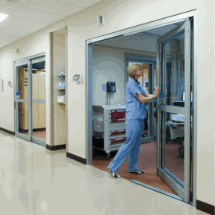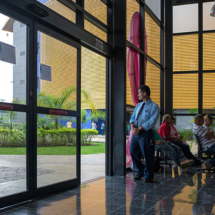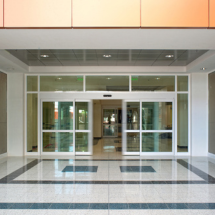Designing Healing Environments: Automatic Doors and Patient Wellbeing
January 29, 2024
Healthcare facilities must be set up to make patients feel as calm and relaxed as possible. Setting a more tranquil mood is essential for ensuring the sick and injured know they are in good hands and aren’t under more pressure in an already difficult time.
While things like lighting and decor are great ways to prep a room for a safe and healing environment, healing architecture is also a must.
Healing architecture uses space and structural design to provide therapeutic and health benefits to those who visit. Automatic doors are one form of healing architecture that can provide plenty of positivity to healthcare facilities, making them accessible, safe, and clean for a quicker recovery.
Healing Architecture in Healthcare Spaces

What is healing architecture? As mentioned above, this type of space design enhances the treatment and care of patients by providing a happy, supportive, and comfortable environment that is sterile and clean.
Rehab centers, medical centers, and nursing homes worldwide have used this form of design to make their facilities feel more welcoming, natural, and inclusive.
Some hospitals have decided adding natural lighting and rooftop gardens is the way to go, while others choose to create wide open spaces and recreation areas for a more diverse feel.
While every facility is different depending on location, the patients they see, and local materials, one thing they should all have in common is accessibility, fluid navigation throughout the entire building, and cleanliness.
Automatic Doors and Healing Environments
Automatic doors play a huge part in creating a safe space for patients and employees in healthcare facilities. These fixtures have improved accessibility, increased safety, added privacy, and decreased the spread of germs in hospitals, doctor's offices, rehab centers, and other healthcare centers.
The benefits of automatic doors turn an otherwise nerve-wracking and anxiety-inducing space into a more welcoming place to receive vital healthcare treatment.
Increased Productivity
Installing automatic doors can improve the productivity of doctors and other employees in healthcare facilities. Doctors can quickly move patients from one hospital area to the next without being redirected due to backed-up traffic at any given door.
Personnel can also reach patients quickly and effortlessly in any emergency, thanks to specific features like breakaway doors.
To look deeper into the effects of healing architecture and employee productivity, let's discuss how room design can impact staff.
Using glass doors provides the opportunity to expose the facility to natural sunlight during the day. A study on 141 nurses working in a hospital setting states, "Exposure to daylight at least 3 hours a day was found to cause less stress and higher satisfaction at work."
Increased Safety
The American Journal of Public Health stated, "During a 22-month period in 1981-82, 250 falls were recorded at a 152-bed acute care specialty hospital in a United States metropolitan area." The study goes on to state that "Of the falls investigated, 29% occurred in the private bathroom attached to each patient room, and two-thirds of those occurred near the toilet."
Using sliding doors and sensors makes these small spaces and rooms more accessible and easier to maneuver through, reducing the risk of falls due to architectural design.
This increase in safety isn't limited to bathrooms, and it can make traveling through all areas and spaces more manageable and attainable for all patients risk-free.
Employees are also safer with quality automatic hospital doors. Many options offer features that add a more comprehensive layer of protection during the workday. Employees can do their jobs better and more confidently without fearing security issues. These features include key card entrances, anti-piggyback and anti-tailgating protection, bullet-resistant glass, and more.
Improved Accessibility
Automatic doors have made it easier for everyone to get around facilities. The door frames are larger for wheelchairs and hospital beds, and sensors are there to open doors without human intervention.
Patients will feel calmer, and happier with more spacious areas and room to move.

Accessibility goes beyond aiding the physically impaired. Innovative automatic doors can also provide aid to those visually impaired and the employees who work in these locations.
Employees can take advantage of these healing environments, too. With space that is easier to navigate, provides proper temperatures and lighting, and offers optimal protection, staff will feel safe and comfortable, thus improving daily mood and services.
Increased Privacy
According to a study on confidentiality and privacy breaches in hospital emergency rooms, "overhearing conversations at the reception desk was the main problem in waiting rooms."
Lack of privacy in waiting rooms, patient rooms, or anywhere else in the healthcare industry can cause stress and anxiety for patients.
Many automatic door options will provide noise-dampening and soundproofing benefits, allowing for better patient-doctor confidentiality.
A quiet space also allows patients to relax and feel more comfortable, whether sitting in the waiting area or prepping for tests in a patient room.
Decreased Spreading of Germs
Automatic doors offer a variety of features that actually help stop the spreading of germs from one person to another.
Of course, with contactless door openers, there is an increase in protection from surface germs that are left on door knobs and handles daily. It is a fact that these surface areas are some of the most common places to find illness-inducing germs, spreading viruses such as the flu, COVID-19, Norovirus, and the common cold like wildfire.
Other ways these types of doors can create a clean and healthy environment to aid a patient's well-being is through isolation doors with air-tight seals and atmospheric sliding doors with ultra-clean, sterile stainless steel. These features ensure viruses are contained in one space and are less likely to spread.
What to Consider When Choosing Automatic Doors for a Healing Environment
The type of doors installed in any healthcare facility will help determine how welcomed, comfortable, and happy the patients visiting will feel. These features, combined with other various design layouts, can increase the well-being and mood of those seen by the doctors in the practice.
A wide range of automatic doors available today can fit into just about any space, increasing patient experience.
Some options to choose from include,
- Revolving doors: These doors offer an appealing architectural design, energy-conserving seals, and wide spaces for wheelchairs and walkers to navigate through.
- Sliding doors: Sliding doors come in an array of designs suited for particular areas of healthcare facilities such as ICU, isolation rooms, and clean rooms and can be used as an entrance system. You can also have them installed with bullet-resistant glass for peace of mind.
- Swinging doors: Automatic swinging doors are ideal when replacing traditional doors to meet ADA standards. These doors increase accessibility and provide wider openings for medical equipment, and walking aids to move through.
- Folding doors: Folding doors are perfect for smaller spaces, offering a quick and easy entrance.
Features to consider for a more healing environment with automatic doors include,
- Glass doors: Glass allows patients to soak in natural sunlight while waiting on doctors or going through treatment.
- Tested seals: High-quality, durable seals ensure the temperatures in the room are ideal for conformability, air-quality control, and privacy.
- Touchless sensors: When there’s no need to touch doorknobs, buttons, and handles when opening a door, the chances of picking up germs decrease significantly, which can be a huge relief to patients, particularly those who are immunocompromised.
- Fire doors: Fire doors are designed to contain a fire in a small area, stopping it from spreading throughout an entire building. In the event of a fire, these doors give you more time to evacuate.
- Breakaway doors: Breakaway doors ensure no one can get trapped inside a room or building in the event of an emergency. This security feature is ideal for those who may be claustrophobic or simply anxious in public spaces. They are also ideal for ICU or patient rooms to easily maneuver hospital beds in and out of a room.
These are just a few features of automatic door systems that benefit a patient's well-being through healing architecture. Working directly with a reputable door installation company like Door Services Corporation is the best way to choose the perfect setup for any healthcare facility.
Purchasing Automatic Doors for Healing Environments
Creating the best space for the ideal healing environment in the healthcare industry requires architectural design and fixtures developed by experts with tons of knowledge and years of experience.
The team at Door Services Corporation knows precisely what it takes to create the perfect space for optimal patient experience, providing an environment that induces a calming, healing, rejuvenating, tranquil, and welcoming feel.
Make sure your patients are always comfortable when walking through your healthcare facility doors by choosing Door Services Corporation for all your industry-leading, advanced technology, and high-quality automatic door needs.





